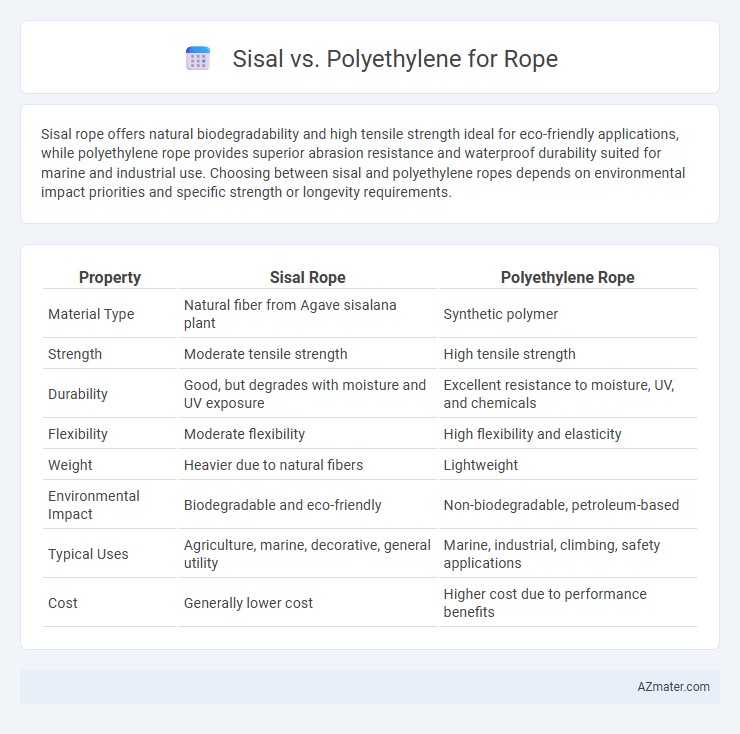Sisal rope offers natural biodegradability and high tensile strength ideal for eco-friendly applications, while polyethylene rope provides superior abrasion resistance and waterproof durability suited for marine and industrial use. Choosing between sisal and polyethylene ropes depends on environmental impact priorities and specific strength or longevity requirements.
Table of Comparison
| Property | Sisal Rope | Polyethylene Rope |
|---|---|---|
| Material Type | Natural fiber from Agave sisalana plant | Synthetic polymer |
| Strength | Moderate tensile strength | High tensile strength |
| Durability | Good, but degrades with moisture and UV exposure | Excellent resistance to moisture, UV, and chemicals |
| Flexibility | Moderate flexibility | High flexibility and elasticity |
| Weight | Heavier due to natural fibers | Lightweight |
| Environmental Impact | Biodegradable and eco-friendly | Non-biodegradable, petroleum-based |
| Typical Uses | Agriculture, marine, decorative, general utility | Marine, industrial, climbing, safety applications |
| Cost | Generally lower cost | Higher cost due to performance benefits |
Introduction: Sisal vs Polyethylene Rope
Sisal rope, derived from natural agave fibers, offers excellent biodegradability and a rough texture ideal for grip and decorative use. Polyethylene rope, a synthetic alternative, provides superior strength, UV resistance, and water repellency suited for marine and industrial applications. Choosing between sisal and polyethylene depends on durability needs, environmental impact, and specific use cases requiring flexibility or toughness.
Material Composition and Properties
Sisal rope, made from natural fibers derived from the Agave sisalana plant, offers excellent biodegradability and strong abrasion resistance but tends to absorb moisture, leading to reduced durability in wet conditions. Polyethylene rope, composed of synthetic polymers, provides superior water resistance, high tensile strength, and exceptional UV resistance, making it ideal for marine and outdoor applications. The choice between sisal and polyethylene ropes hinges on material composition, with sisal favored for eco-friendly uses and polyethylene preferred for longevity and performance in harsh environments.
Strength and Load-Bearing Capacity
Sisal rope offers moderate tensile strength with a natural fiber composition, making it suitable for light to medium load-bearing tasks but prone to abrasion and degradation under heavy stress. Polyethylene rope provides significantly higher strength and superior load-bearing capacity due to its synthetic, high-molecular-weight construction, offering excellent resistance to moisture, chemicals, and UV exposure. For applications demanding maximum durability and strength, polyethylene rope outperforms sisal by maintaining integrity under extreme loads and harsh environmental conditions.
Durability and Lifespan
Sisal rope is biodegradable and offers moderate durability, making it suitable for light to medium tasks but prone to fraying and rotting when exposed to moisture over time. Polyethylene rope excels in durability and lifespan due to its resistance to UV rays, chemicals, and water, maintaining strength and flexibility even in harsh outdoor conditions. For long-term use in marine or industrial applications, polyethylene significantly outperforms sisal in terms of longevity and resistance to environmental degradation.
Resistance to Weather and Chemicals
Sisal rope offers moderate resistance to weather and chemical exposure, decomposing faster under prolonged moisture and UV radiation, making it less durable for harsh outdoor conditions. Polyethylene rope exhibits superior resistance to water, UV rays, and various chemicals, maintaining strength and flexibility even in marine and industrial environments. For applications demanding extended weathering and chemical exposure, polyethylene provides a more reliable and long-lasting solution compared to natural sisal fibers.
Environmental Impact and Sustainability
Sisal rope, derived from the natural fibers of the Agave sisalana plant, offers significant environmental benefits due to its biodegradability and renewable sourcing. Polyethylene ropes are synthetic, made from non-renewable petroleum resources, and do not decompose easily, contributing to long-term plastic pollution. The sustainable cultivation of sisal, combined with its natural degradation, positions it as a more eco-friendly alternative compared to polyethylene in marine and agricultural applications.
Cost Comparison
Sisal rope generally costs less than polyethylene rope due to its natural fiber origin and simpler manufacturing process, making it an economical choice for applications requiring biodegradability. Polyethylene rope, while more expensive, offers superior durability, abrasion resistance, and UV stability, which can reduce replacement frequency and lower long-term expenses. Evaluating the total cost of ownership involves considering both initial purchase price and lifespan based on specific usage conditions.
Common Applications and Use Cases
Sisal ropes are commonly used in gardening, agriculture, and decorative applications due to their natural fiber qualities, biodegradability, and grip texture ideal for ties, plant supports, and rustic decor. Polyethylene ropes excel in marine, industrial, and outdoor recreational use because of their high resistance to water, UV rays, and abrasion, making them perfect for mooring, climbing, and safety equipment. Both materials suit different environmental conditions and durability needs, with sisal favored for eco-friendly, non-load-bearing tasks and polyethylene chosen for heavy-duty, long-lasting performance.
Maintenance and Handling Requirements
Sisal rope requires regular maintenance to prevent moisture absorption, which can lead to rotting and weakening, and it benefits from drying after exposure to water to maintain durability. Polyethylene rope offers superior resistance to water, UV rays, and chemicals, requiring minimal upkeep and retaining strength without frequent drying or treatment. Handling polyethylene rope is easier due to its lightweight and flexibility, whereas sisal rope can be rougher and more prone to abrasion, necessitating careful handling to avoid fraying.
Choosing the Right Rope: Key Considerations
Sisal ropes offer natural biodegradability and excellent grip, making them ideal for outdoor applications and eco-friendly projects, while polyethylene ropes provide superior strength, resistance to moisture, and longevity in harsh environments. When choosing between sisal and polyethylene, consider factors such as UV exposure, load-bearing capacity, abrasion resistance, and environmental impact. Selecting the right rope depends on the specific use case, balancing durability needs with sustainability goals to ensure optimal performance.

Infographic: Sisal vs Polyethylene for Rope
 azmater.com
azmater.com